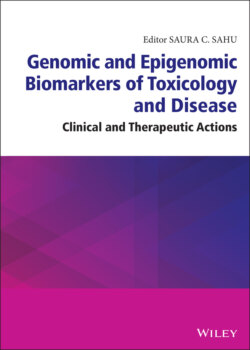Читать книгу Genomic and Epigenomic Biomarkers of Toxicology and Disease - Группа авторов - Страница 60
Circulating miRNAs Associated with Chromium Exposure
ОглавлениеChromium (Cr) is the seventh most abundant element on the earth. As a transition metal, chromium can occur in any of the oxidation states from -II to +VI, but it is mostly found in oxidation states 0, +III, and +VI (Sperling 2005). In the environment, chromium can occur in hexavalent (Cr(VI)) or trivalent (Cr(III)) species (Nath et al. 2009). Cr(VI) has been classified as Group I human carcinogen (Proctor et al. 2014; Straif et al. 2009). Hexavalent chromium is used extensively in industry, for instance in leather tanning, in textile and pigment manufacturing, in stainless steel production, and in welding, polishing, and grinding (Wang et al. 2017). Occupational exposure is thus a major concern, primarily because of inhalation. Once absorbed, chromium circulates in the blood, getting bound to the β-globulin plasma fraction, and is transported to tissues after being complexed with transferrin or other proteins (Pechova and Pavlata 2007). Within cells, hexavalent chromium compounds undergo reduction by ascorbate and non-protein thiols, cysteine, and glutathione, and this leads to the formation of transient and highly reactive Cr(V) and Cr(IV) species, organic radicals, and, finally, Cr(III) products (Manning et al. 1994; Salnikow and Zhitkovich 2008; Wang et al. 2017). Intermediate chromium forms are mostly responsible for oxidative stress and DNA damage, which they do by inducing chromium–DNA adducts, DNA strand breaks, and DNA–protein cross-links, all known to contribute to mutagenesis and carcinogenesis (O’Brien et al. 2003; Wang et al. 2017; Wise et al. 2002).
The acute effects of inhaled hexavalent chromium include shortness of breath, coughing, and gastrointestinal and neurological effects (IARC 1990; USEPA 1998). The chronic inhalation of hexavalent chromium causes ulcerations of the septum, bronchitis, pneumonia, decreased pulmonary function, and increased risk of developing respiratory system cancers, primarily bronchogenic and nasal (IARC 1990; USEPA 1998). The chronic inhalation of high levels of hexavalent chromium induces liver, kidney, and gastrointestinal damage (IARC 1990; USEPA 1998).
Several studies have investigated chromium-induced circulating miRNA dysregulation. miRNA profiles from Chinese workers involved in the production of chromate revealed lower levels of miR-3940-5p associated with high levels of hexavalent chromium in blood (Li et al. 2014). In addition, plasma levels of miR-3940-5p were positively correlated with micronuclei frequency in the hexavalent chromium-exposed group (Li et al. 2014). The micronuclei test has been recognized as a reliable biomarker of genotoxicity in occupationally chromium-exposed individuals (IARC 1990; Sudha et al. 2011). Therefore miR-3940-5p could in principle be a biomarker of chromium exposure linked to genetic damage. A very recent study observed forty-five significant differentially expressed miRNAs in the plasma of hexavalent chromium-exposed workers from China (Jia et al. 2020). RT-qPCR validated both the decreased levels of miR-19a-3p, miR-19b-3p, and miR-142-3p and the increased levels of miR-590-3p and miR-941 in the hexavalent chromium-exposed group (Jia et al. 2020). Expression levels of miR-143 were decreased, whereas Interleukin 6 (IL-6) was increased in the blood samples of hexavalent chromium-exposed workers by comparison with the samples of unexposed workers (Wang et al. 2019). Only one study attempted to better understand the linkage between chromium, miRNAs, and metabolic and cardiovascular diseases. Blood levels of forty-three miRNAs were negatively associated with chromium in the urine of obese subjects in Italy (Dioni et al. 2017). By RT-qPCR, nine miRNAs (miR-451, miR-301, miR-15b, miR-21, miR-26a, miR-362-3p, miR-182, miR-183 and miR-486-3p) were downregulated in association with chromium in urine. miR-451 was further associated with glycated hemoglobin, whereas miR-486-3p was associated with both diastolic and systolic blood pressure in obese subjects who presented urinary chromium (Dioni et al. 2017). These two circulating miRNAs can be considered putative biomarkers of chromium exposure, and their relation with glycated hemoglobin and blood pressure may give insights into chromium-induced metabolic and cardiovascular diseases (Dioni et al. 2017). In summary, studies so far demonstrate a differential expression of several miRNAs upon chromium exposure, albeit with no overlap of a single miRNA across all these studies. This inconsistency is a major caveat, given that all the studies have been conducted on the Chinese population and further substantiation of these findings across other exposed populations is required.
